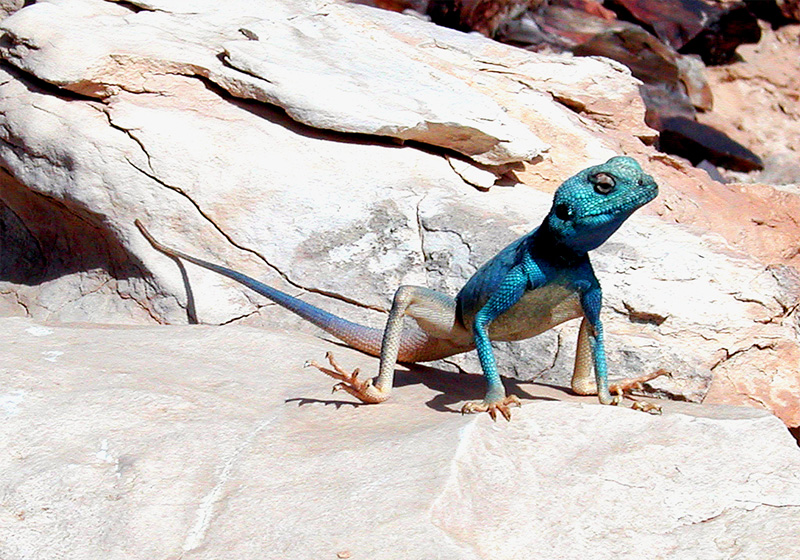Azure Lizard
"Badia" or "Eastern Desert" are terms usually given in general to flat parts of Jordan that lie east of the Hijaz Railroad. But the word "desert" is a misnomer in many cases, as there are a number of locations within this wide expanse of land that have a surprising vegetation cover. While most of the Badia has an average altitude of 600 meters above sea level, the land 30km to the southeast of the airport rises up to a surprising height of almost 1000 meters. This means that such a height gets much of the winter snow, and more rain, as the landscape pushes the clouds upwards helping them to condense and squeeze out their water.
In this highland, north of the road to Qasr Tuba and all the way to Wadi Al Shammout and Wadi Al Dab’i, colorful outcrops of marble alternates with white limestone (different colors of Dab’ah marble) striping the hillsides and adding an element of ornamentation. Also noticeable is a carpet of short vegetation, which gives the rolling hills a fur, few centimeters thick.
On an edge of the typical white limestone with chert, a lizard of rare blue posed under the sharp sun. As if carved out of lapis lazuli or malachite, hardly any motion except the fluctuating skin below the jaws, it stood brilliantly like a piece of jewelry of the most precious kind.

Seeing the alien visitor from Amman moving around for a better photograph, the lizard swiftly entered an alcove of shade below the sunlit rock-edge. Still visible, and trying to understand the unfamiliar space-invader, it slowly gathered some courage and stepped back into the sun, and climbed again atop its favorite highpoint. The following half hour or so were like a fashion show, posing, turning and posing again, for photos in different positions.
The blue Sinai Lizard (Agama sinaita) lives basically in southern Jordan in the mountains of Dana, Petra and further south. As the scientific name suggests, its habitat extends to Sinai and possibly other high mountains in the region of the Red Sea. It was surprising to find this lizard in the eastern desert, northeast of Qatarana, in the hills of Dab’ah. There are also slight differences in color between the lizards seen in Petra and this Dab’ah lizard. In Petra, the lizard's blue is more intense, darker, and more indigo-like with a slight tint of violet. In Dab’ah, the lizard was of turquoise-blue, paler, and with a white belly. What is stunningly beautiful in the colors of the Petra lizard is that the skin, on the back spine, has a line of shiny golden spots dissolving gradually into the sides of the darkest indigo. Although many refer to these lizards as changing their color according to the surroundings and present conditions, I haven’t noticed much of such changes. The differences in color and size (the Petra lizard is slightly bigger - 20cm) might also suggest different sub-species. It is also worth noting that this lizard is rare, I’ve seen it only once in Petra during some 10 days of walking in the site in 1994, and only once in the eastern desert in 2003.
Why this brilliant blue? Definitely not for camouflage -blue is the rarest color on the Jordanian landscape surface. Except for the clear sky and its reflection in water, our rocky terrains have almost all the colors of the spectrum except for blue. In Petra, on the other hand, the prevailing sandstone color of rust-red is, in fact, the exact opposite of the color of this lizard. If it is not for camouflage, then perhaps the blue is performing another function, as living nature, usually, has functional and meaningful designs.
We might think of the lizard’s skin as a light filter, a kind of a sun-block, which the lizard wears permanently. We might also note that seeing the color blue means the lizard is absorbing all the color spectrum except for blue which gets blocked and reflected back to us. Maybe the lizard doesn’t like ultra-violet with its adjacent visible colors, violet and blue, and thus filters them out. In such a case its skin is collecting more of the oranges, reds and infrareds –the complementary colors of its blue skin. This might make more sense in understanding the beautiful blue of this inquisitive, sun-loving and harmless lizard, especially if we remember that this cold-blooded reptile has to collect heat from outside its body to carry on its daily activities.
Whatever the secrets of the way this creature plays with the colors of the rainbow, we remain to be intrigued and entertained by its company, sharing our colorful home –Jordan- with us.
The highland to the east of the town of Dab’ah is a wonderful destination. Reaching elevations of almost to 1000 meters above sea level, this area is cool, even in midsummer. Drive south on the Desert Highway - before Qatarana, exit on the road to Qasr Tuba, and after driving for 3-4 kilometers eastwards, head northeast on a network of dirt roads. Driving deeper in this area will bring you eventually to Wadi Al Dab’i some 20 kilometers south of Harraneh, or to Qasr Tuba deep in the eastern desert. A reliable 4x4, a GPS with enough batteries, a good map, a hat, and a lot of water are minimum requirements. You may spot the blue lizard, or you may –most likely- never see it at all, but this land is full of surprises and you might discover other things that may be even more fun. In Petra, the best bet is to walk around the site for a couple of days, concentrating on unbeaten tracks on the way to Nabi Haroun, in the terrain of Wadi Thalma northeast of the Treasury, or in Wadi Sabra in the southern parts of Petra.